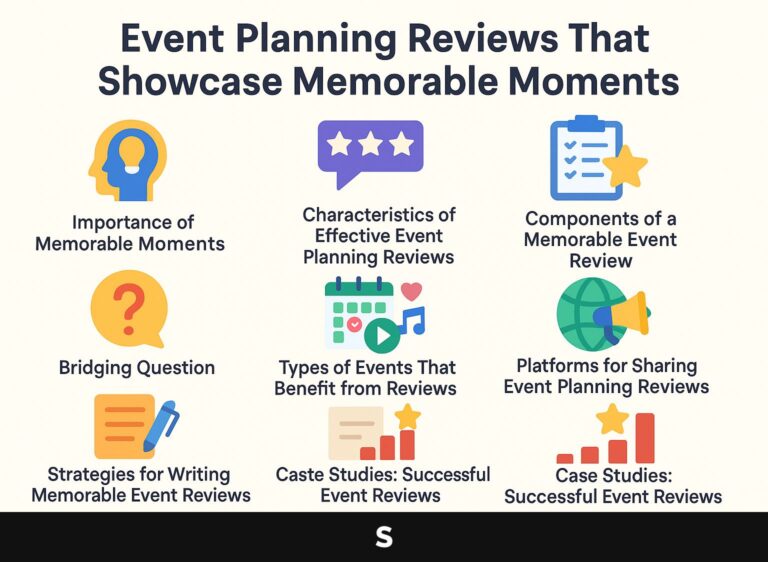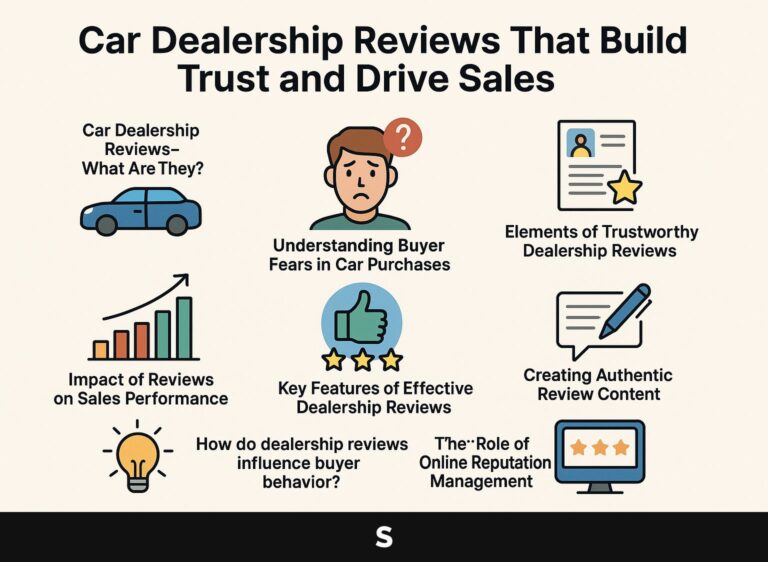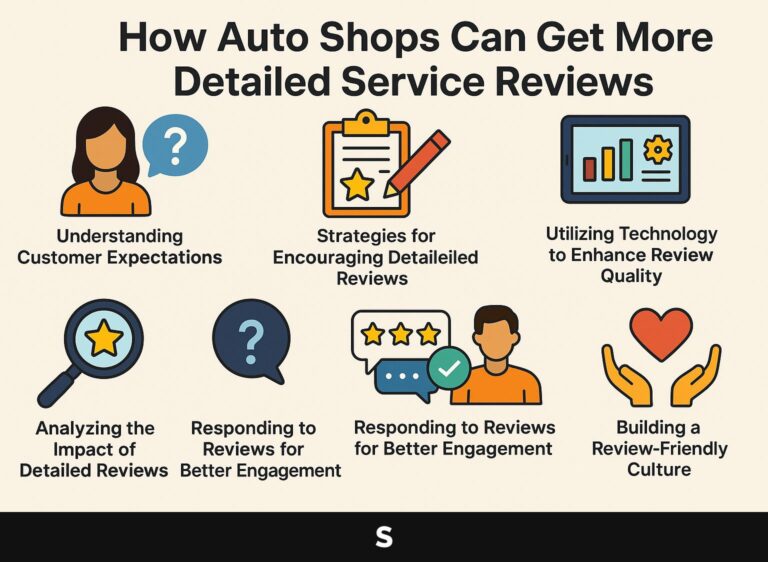Transform Short Feedback into Powerful Marketing Testimonials
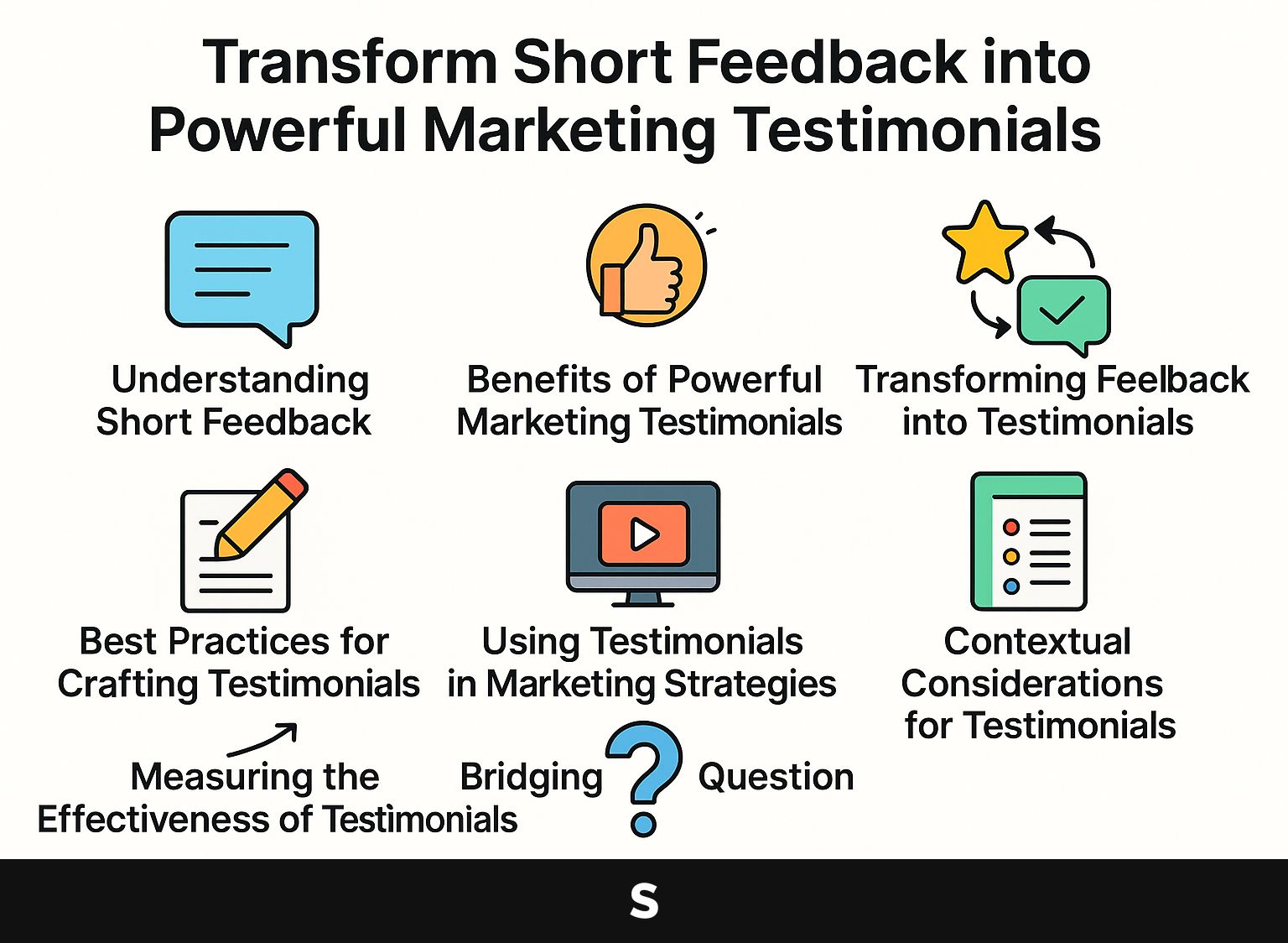
Quick customer feedback can often get overlooked because of the large number of online reviews on sites like Google Business, Yelp, and TripAdvisor. However, with Spokk.io, you can turn those quick comments into strong marketing testimonials that make an impact. This article explains how to turn short feedback into strong stories that improve social proof, increase interaction, and highlight what makes you special in social media and marketing materials. Make the most of your customer feedback today!
Key Takeaways:
- Turn Brief Feedback into Strong Marketing Endorsements
- Understanding Short Feedback
- Benefits of Powerful Marketing Testimonials
- How testimonials increase reliability and confidence
- Impact of testimonials on conversion rates
- **Importance of testimonials in customer choices** Testimonials are important in how customers make choices. When people share their experiences with a product or service, it helps others decide if it’s worth trying. These personal stories can give potential customers confidence and trust in their decisions. Testimonials act as recommendations from real users, making them a helpful tool in the buying process.
- Transforming Feedback into Testimonials
- Writing Effective Testimonials
- Using Testimonials in Marketing Strategies
- Measuring the Effectiveness of Testimonials
- Bridging Question
- Things to Keep in Mind for Testimonials
- Frequently Asked Questions
- Why change brief feedback into strong marketing reviews?
- How does Spokk.io convert short comments into effective marketing testimonials?
- Why are marketing testimonials important for businesses?
- Can marketing testimonials be used in different forms of marketing?
- How can businesses use AI-powered testimonials to distinguish themselves from their competitors?
- Are there any specific guidelines for creating powerful marketing testimonials?
Turn Brief Feedback into Strong Marketing Endorsements
Turning short customer comments into strong testimonials can greatly improve your marketing approach by changing simple phrases into detailed stories that connect with possible clients.
How do you turn feedback into testimonials?
Turning feedback into testimonials means turning short customer comments into detailed statements that emphasize particular benefits, distinct advantages, and how the customer felt about their experience.
To effectively elaborate on feedback, start by identifying key themes. For example, if a customer praises the user-friendliness of Spokk.io, dig deeper by asking how this ease of use has improved their workflow.
Use tools like Google Forms to collect more information from clients. Another method is to analyze customer comments for patterns, such as common frustrations that Spokk.io resolves.
By displaying these detailed testimonials on your website, you show your product’s benefits and help potential customers connect with and trust the stories shared.
Why are testimonials important for marketing?
Testimonials are important for showing that your brand is trustworthy. They help build confidence and credibility, especially in online marketing where people often depend on others’ views.
Studies show that featuring testimonials can increase conversion rates by up to 34%. Ask happy customers to write reviews on sites like Google or Yelp, and show these reviews on your website.
By using tools like Trustpilot, you can collect and show real reviews that connect with possible customers. Integrating customer stories in marketing materials or social media posts allows prospects to envision themselves benefiting from your product, further influencing their purchase decisions.
Understanding Short Feedback
Understanding short feedback helps companies make better use of customer data, improve marketing, and create stronger customer connections. To delve deeper, see also: Ultimate Guide To Customer Feedback Strategy For Business.
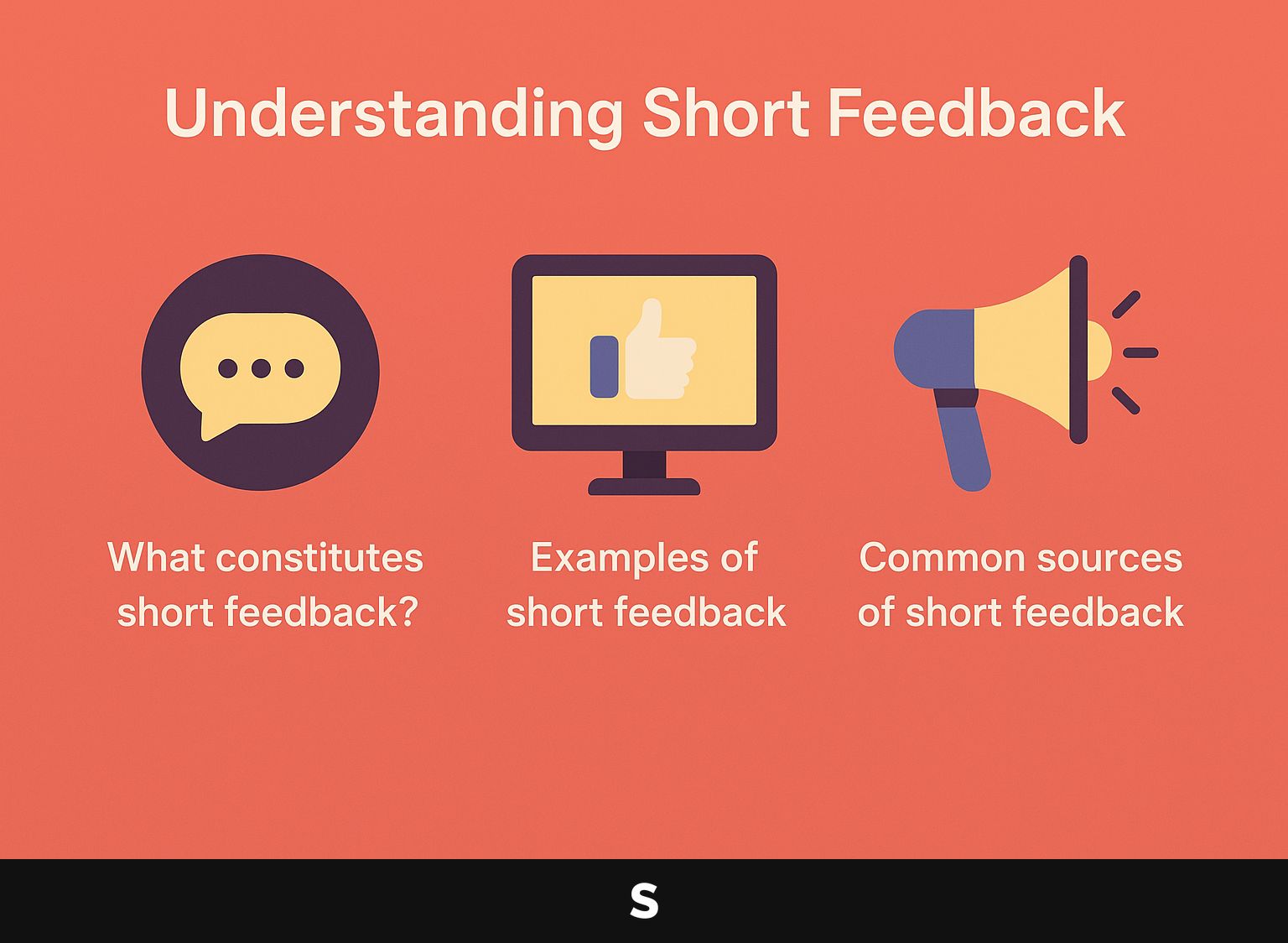
What constitutes short feedback?
Short feedback typically consists of brief comments or ratings from customers that encapsulate their experience with a product or service in just a few words.
To create impactful testimonials, collect feedback using specific formats like star ratings, which can visually represent customer satisfaction, or concise one-liners drawn from surveys.
For example, a 5-star rating with a comment like “Exceeded my expectations!” conveys strong approval.
Convert comments from social media, like “This product changed my life! into organized testimonials. Use Google Forms to create surveys and Canva to make eye-catching graphics for testimonials.
This method increases credibility and builds trust with potential customers.
Examples of short feedback in various industries
Across industries, short feedback varies; for instance, a restaurant might receive ‘Great food!’, while a software company may get ‘User-friendly interface!’ from customers, highlighting sector-specific sentiments.
In hospitality, feedback is often focused on service quality and ambiance. For example, a hotel might receive comments like:
- ‘Exceptional staff!’
- ‘Well-decorated rooms!’
In contrast, tech companies might get constructive critiques on functionality, such as:
- ‘Needs better integration with third-party apps!’
- ‘Love the security features!’
Retail feedback frequently centers on product variety and customer service, evident in comments like:
- ‘Impressive stock!’
- ‘Helpful staff!’
Feedback from each area shows what customers think and offers practical ideas for improvement.
Common sources of short feedback include online surveys, social media platforms like Facebook and Twitter, and review sites such as Yelp and Google Business.
To collect and use this feedback effectively, consider tools like ReviewTrackers, which brings reviews from various platforms together, making it easier to see what customers think.
Trustpilot provides a reliable way to collect reviews and ratings, allowing you to establish trust. Using social media listening tools like Hootsuite can give immediate information about what customers think.
Regularly checking this feedback helps businesses change their strategies, improve customer satisfaction, and solve issues quickly.
Benefits of Powerful Marketing Testimonials
Strong marketing testimonials can greatly increase customer trust and confidence, resulting in better interaction and higher conversion rates for businesses in different industries.
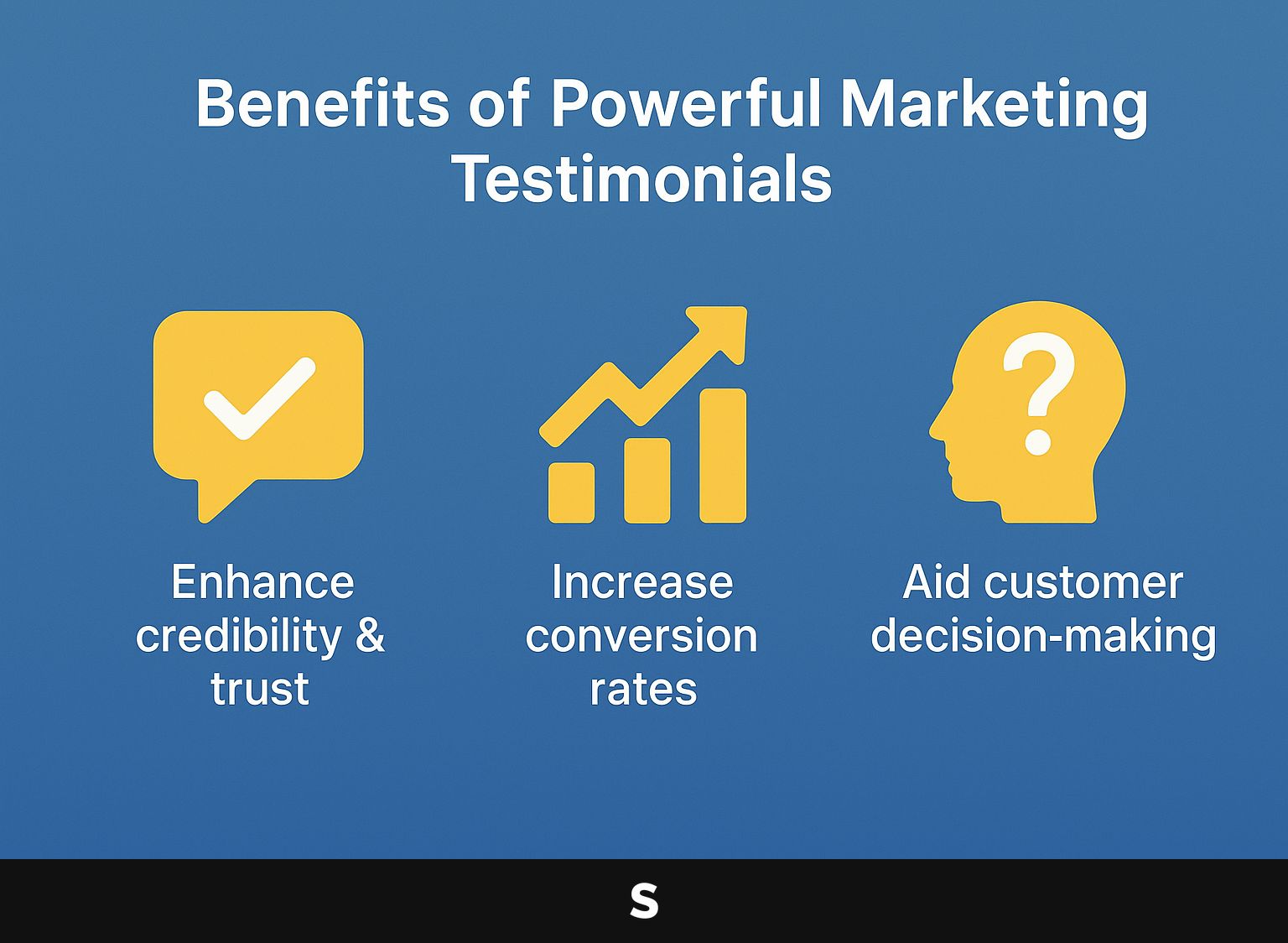
How testimonials increase reliability and confidence
Testimonials build trust by offering potential customers real-life stories that confirm the quality and usefulness of a product or service.
Research shows that about 92% of consumers trust recommendations from friends and family more than any form of advertising. For using testimonials well, think about these approaches:
- Collect specific feedback that highlights key features.
- Use video testimonials to create emotional connections.
- Display reviews prominently on your website.
You can collect and display customer feedback using tools like Trustpilot or Yelp. Testing different positions for reviews on your site can improve your conversion rates. Implementing these methods can significantly influence purchase decisions.
Impact of testimonials on conversion rates
Research shows that businesses using testimonials can see a conversion rate increase of up to 34%, highlighting their effectiveness as a marketing tool.
To make use of testimonials, gather opinions from happy customers and show them clearly on your website. For example, using platforms like Trustpilot or Google Reviews can make you seem more trustworthy.
A simple example: If your product sells for $100 and you convert 10% of visitors with testimonials, that’s an additional $340 in revenue per 1000 visitors (34 conversions).
To maximize ROI, regularly update testimonials and encourage customers to share experiences through post-purchase emails or social media. Engaging visuals and specific success stories can further strengthen their impact.
Testimonials are important in helping customers decide, as they show proof that makes potential buyers feel confident about their purchase decisions.
For instance, a recent study showed that 79% of consumers trust online reviews as much as personal recommendations.
Using platforms like Trustpilot or Yelp, businesses can gather and display authentic testimonials.
Including case studies showcasing specific results-like a 30% increase in sales after implementing a service-can further validate claims. This mix of personal opinions and numerical data strengthens trust and helps encourage consumers to make a purchase.
Therefore, prioritizing genuine testimonials in your marketing strategy is essential.
Transforming Feedback into Testimonials
Turning basic feedback into detailed testimonials needs a step-by-step process that uses both creative thinking and technology, especially AI tools such as Spokk.io.
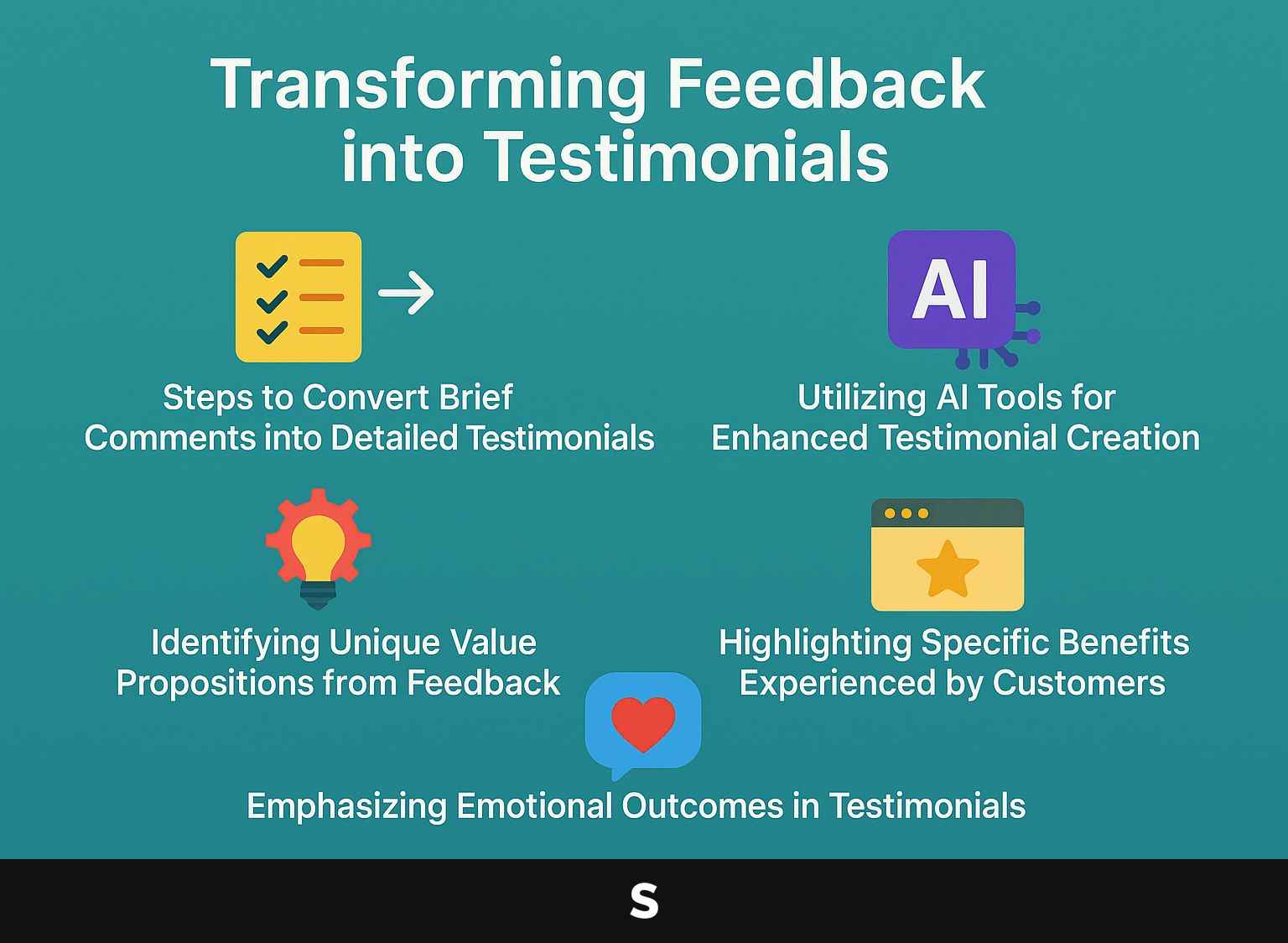
Steps to convert brief comments into detailed testimonials
- Identify key feedback elements.
- Expand on each element to create a narrative.
- Highlight emotional responses.
Begin by selecting the most impactful quotes from your feedback. For example, if a customer notes, ‘This product changed my life,’ ask them to elaborate.
Why did it change their life? Did it solve a specific problem? After you have gathered this information, turn it into a story that focuses on their experiences.
Use storytelling techniques by including obstacles they faced and how your product became a solution.
Make sure the testimonial shows real feeling, as this connection can greatly affect potential customers.
Using AI tools to improve testimonial creation
AI tools like Spokk.io can make it easier to turn brief feedback into full stories by reviewing and adding details automatically.
Using Spokk.io’s semantic analysis tools, you can find repeating topics in customer feedback-like satisfaction, how useful the product is, or the quality of support.
For instance, if you receive a review highlighting excellent customer service, Spokk.io can extract this sentiment and expand it into a detailed narrative that emphasizes reliability and responsiveness.
The tool’s AI suggestions can help you focus on certain emotions, making testimonials easier to relate to and more impactful.
This way, the testimonials show real experiences and connect well with possible customers.
Identifying unique value propositions from feedback
Finding special features from feedback helps make testimonials that connect with possible customers and show the true advantages of your product or service.
To extract these propositions, start by analyzing feedback for common themes. Tools like SurveyMonkey or Typeform can help gather structured feedback from customers.
For instance, if multiple users highlight how a product saves time, this can be a focal point for your testimonials. Look for exact words clients use-such as ‘user-friendly’ or ‘simple.’ Using quotes with these terms can make your message easier to connect with.
A sample testimonial could state: ‘This software has sped up our work, allowing us to save several hours each week.’ This shows the real benefits and shares customer opinions.
Highlighting specific benefits experienced by customers
Sharing specific customer benefits in testimonials helps potential buyers see the real value of your products.
To effectively draw out specific benefits, ask customers targeted questions during feedback sessions. Ask how your product fixed a specific issue or improved their work process.
Use tools like SurveyMonkey or Typeform to collect structured feedback. After collecting feedback, turn these into testimonials by directly quoting your customers’ words.
For example, if a customer talks about better productivity, say, “Thanks to [Your Product], my team was 30% more productive in just two weeks!” This way, you share relatable stories that connect with possible customers.
Emphasizing emotional outcomes in testimonials
Showing how customers feel in testimonials can help attract new customers and make your brand appear more genuine and reliable.
To create emotional effects, concentrate on personal stories that show life-changing experiences. For instance, a fitness center might feature a client who lost weight and gained confidence, mentioning how the supportive community changed their life.
Tools like VideoAsk help record these sincere stories through video testimonials, letting customers show real emotion. Using phrases that trigger feelings, like ‘I never thought I could,’ can make emotions feel more intense.
Sharing these experiences can greatly improve how relatable and trustworthy your brand appears.
Writing Effective Testimonials
Creating useful testimonials involves following guidelines that make sure they connect with people and clearly show the benefits of a product or service.
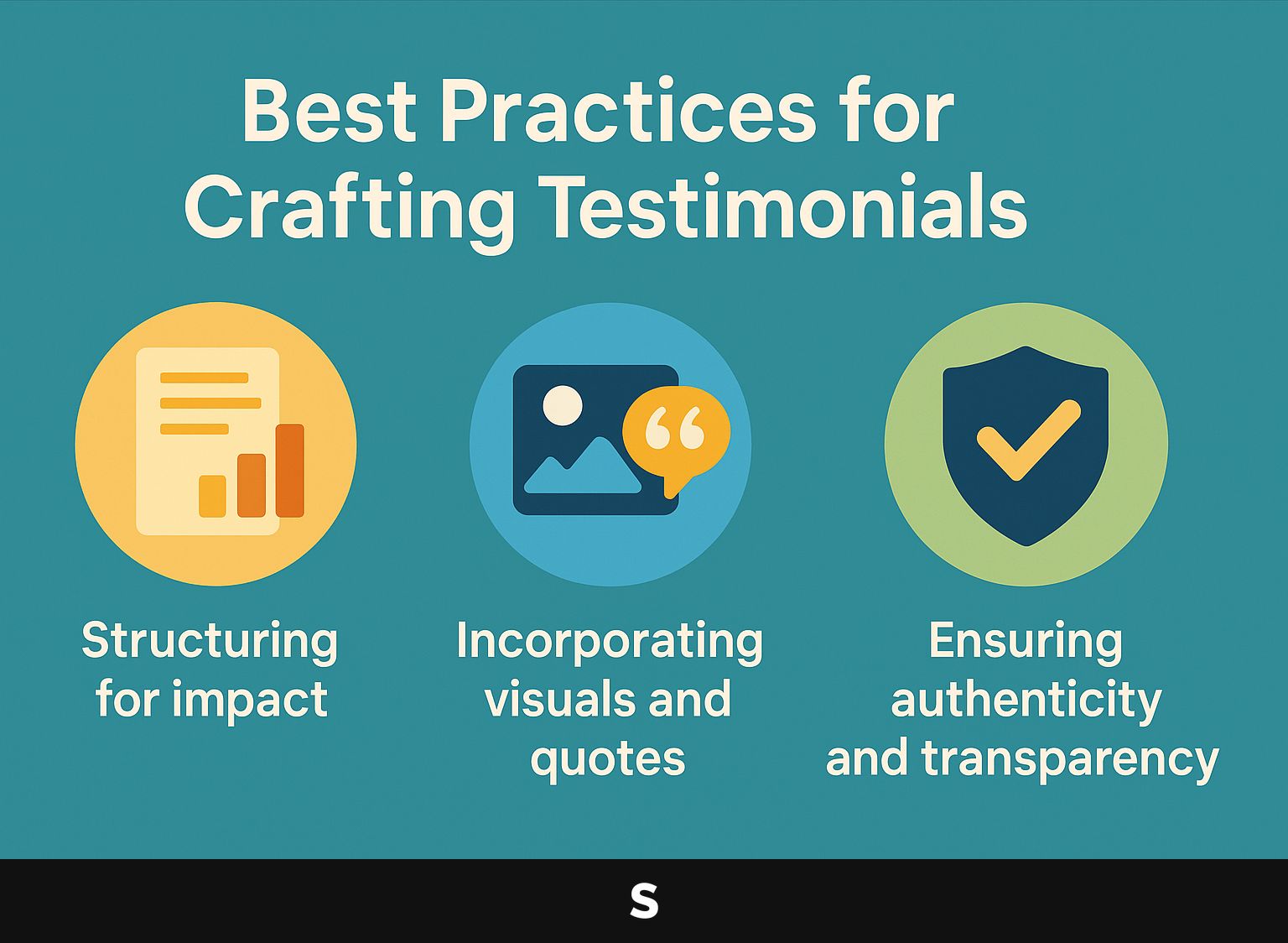
Structuring testimonials for maximum impact
Testimonials should be structured in a way that maximizes their impact, typically following a format that includes the customer’s name, their experience, and a clear statement of benefits.
To create an effective testimonial, start with the customer’s name and location for authenticity. Next, include the particular problems that your product or service solved for them.
For example, ‘Sarah from Denver had trouble managing her time until she started using TaskMaster. It simplified her daily schedule and increased her productivity by 30%.’ Suggest they end with a strong recommendation, such as, ‘I can’t imagine living without it!’
This structure strengthens your credibility and clearly explains the benefits you offer.
Incorporating visuals and quotes effectively
Adding images and quotes to testimonials can make them look better and work better, capturing the audience’s attention.
To make testimonials more relatable, integrate customer photos or short video snippets alongside the text. For instance, use candid shots of happy customers using your product, which can evoke trust and authenticity.
In a video testimonial, a customer can express their experience directly, conveying emotions and credibility more effectively than text alone. Tools like Canva can help create visually appealing layouts, while platforms like Vimeo allow for easy video embedding.
Use 70% visuals and 30% text to keep people interested and provide the needed details.
Ensuring authenticity and transparency in testimonials
Keeping testimonials real and honest is important for keeping customer trust and believability in your marketing efforts.
To verify testimonials, begin by checking the reviewer’s credibility-look for LinkedIn profiles or social media presence that corroborate their identity.
Use tools like Trustpilot or Google Reviews to cross-reference their feedback on independent platforms. Consider contacting clients directly for more detailed information.
Showing the reviewer’s name and where they are from makes things clearer. For best practices, consider creating a simple verification process that includes a confirmation email to request permission before displaying their feedback publicly.
Using Testimonials in Marketing Strategies
Using testimonials in different marketing strategies can increase awareness and involvement, making them a useful tool for marketers. One of our most insightful case studies demonstrates how choosing the right platform can amplify the impact of testimonials.
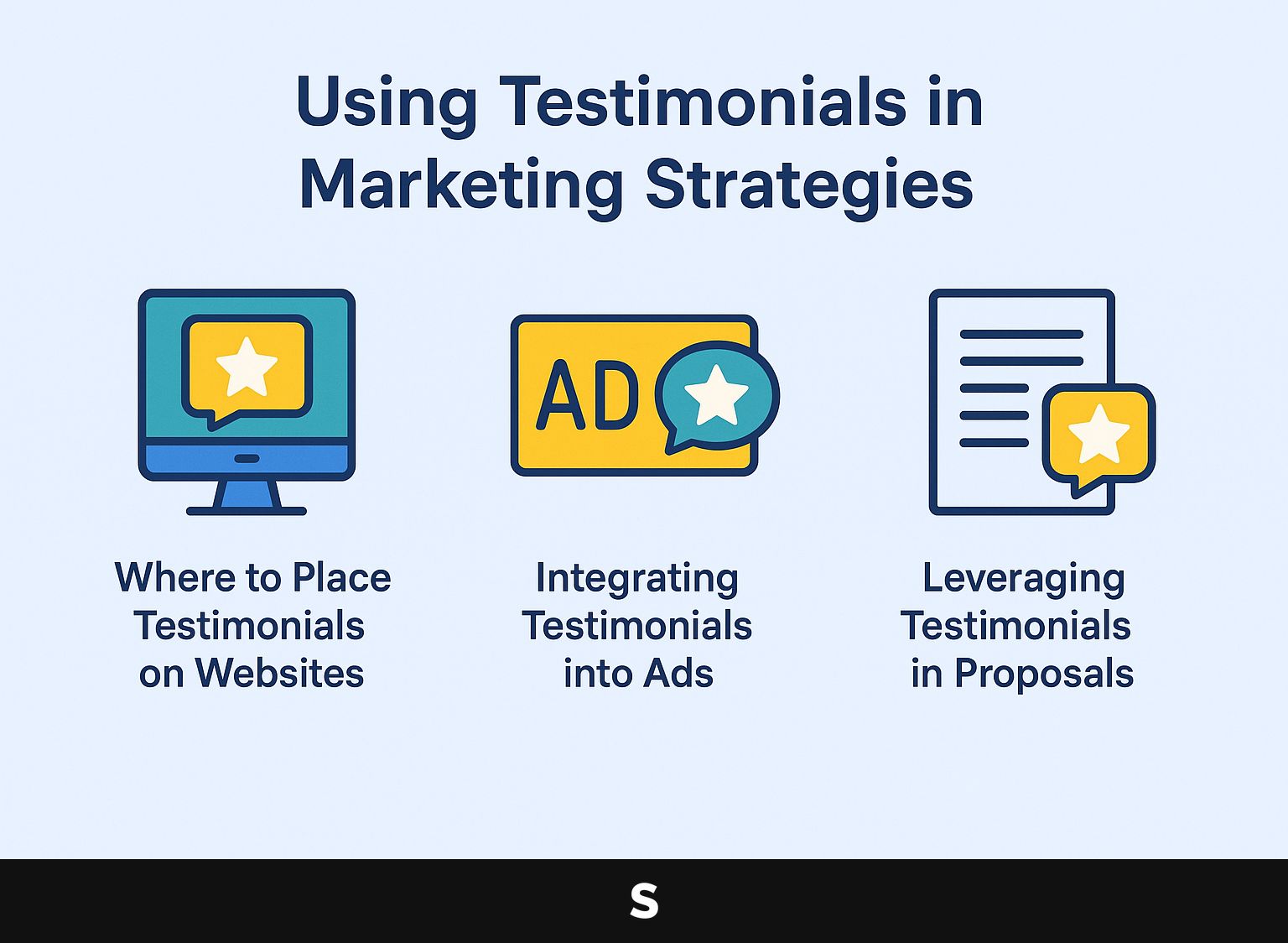
Where to place testimonials on websites for visibility
Putting testimonials in key spots on your website can make them more noticeable. You can add them to homepages, product pages, or specific sections for testimonials.
To maximize impact, consider implementing testimonials above the fold on your homepage, ensuring they are the first thing visitors see.
On product pages, put them close to the call-to-action button; this can increase conversions as potential buyers feel more confident.
A page focused on testimonials can gather customer stories, and adding video testimonials can make it more interesting and genuine.
Tools like Trustpilot or Yotpo can help you gather and display these testimonials effectively, further enhancing their credibility.
Integrating testimonials into advertisements
Adding customer testimonials to advertising campaigns can increase their reach and effectiveness, using customer opinions to improve brand communication.
To use testimonials well, include short quotes from happy customers in your online ads, like social media posts or Google Ads.
For example, a beauty brand might showcase a glowing review in a sponsored Instagram post, emphasizing a specific product benefit.
In print media, a strong testimonial can be featured prominently in brochures or flyers; a restaurant might showcase a customer’s enthusiastic review of a popular dish.
Tools like Canva can help design attractive visuals, making testimonials stand out to your intended audience.
Using testimonials in proposals and pitches
Using testimonials in proposals and pitches can make your arguments stronger by showing that others trust and approve of your products or services.
To maximize their impact, choose testimonials that directly relate to the specific benefits your proposal offers. For instance, if you’re pitching a marketing service, include a testimonial from a client who saw measurable growth in their campaign.
Present these testimonials prominently, perhaps in a dedicated section with pull quotes or visually highlighted text. Consider using video testimonials for added authenticity; tools like Vidyard or Loom can help create these engaging formats.
This careful choice and presentation make your proposal both convincing and easier to connect with.
Measuring the Effectiveness of Testimonials
Checking how well testimonials work is important to see how they affect your marketing and to plan better for the next steps.
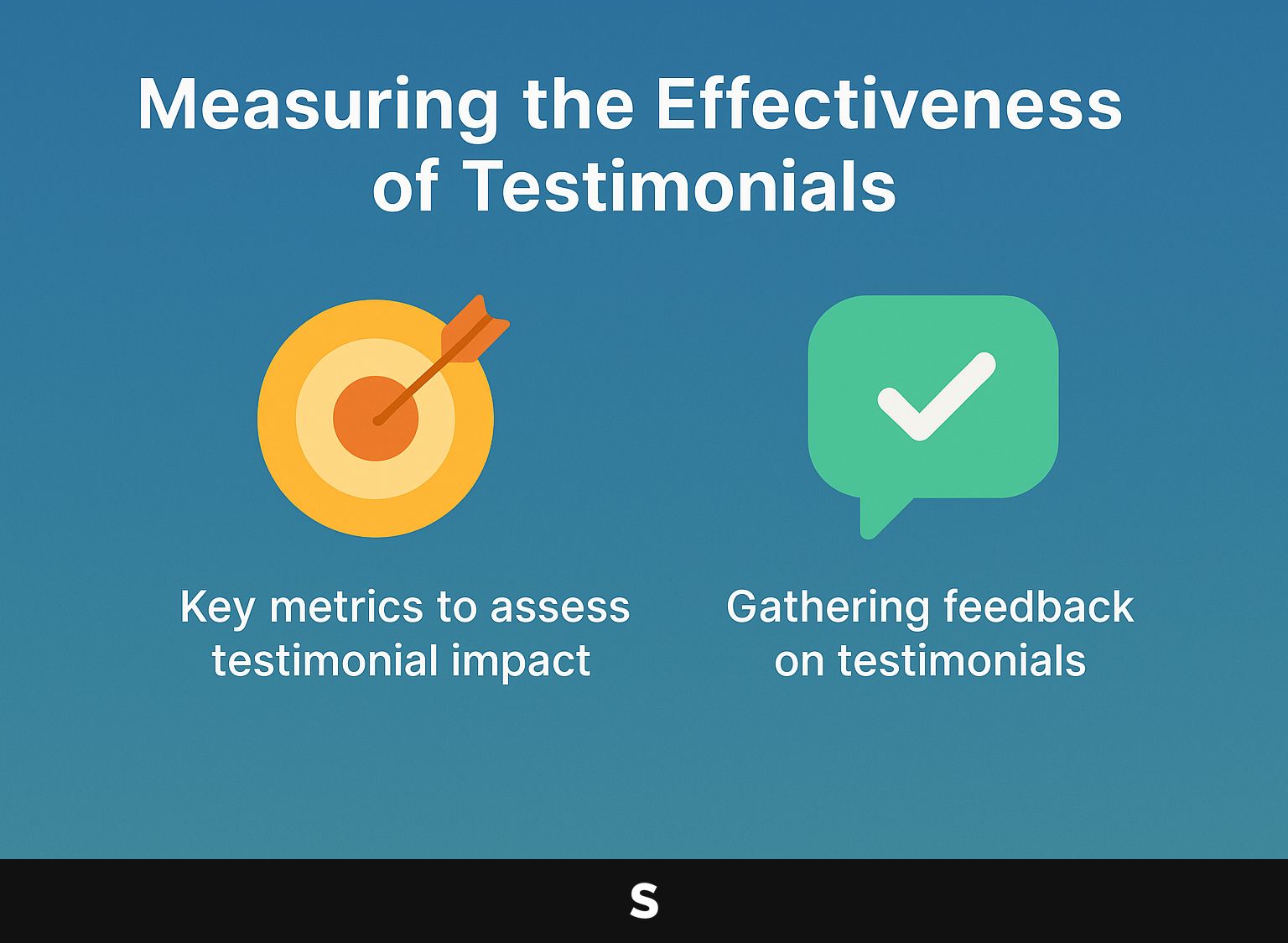
Key metrics to assess testimonial impact
Important numbers to look at when judging how testimonials work are conversion rates, click-through rates, and customer retention rates. These numbers show how well the testimonials are working.
To measure these metrics accurately, use tools like Google Analytics and Hotjar.
For example, set up conversion tracking in Google Analytics to see how testimonial placements influence purchases. You can also employ A/B testing to compare pages with and without testimonials, adjusting based on performance.
Using tools like HubSpot can help track customer retention rates over time by monitoring engagement metrics post-testimonial implementation.
Gathering opinions through surveys can increase knowledge of how testimonials affect user choices.
Gathering feedback on testimonials for continuous improvement
Getting opinions on reviews can help you do better, making sure your marketing messages relate to your audience and reflect current customer opinions.
Use tools like Google Forms or Typeform to make fast surveys. Ask customers to rate how helpful the testimonials are and to share their opinions.
Use A/B testing by trying different testimonial formats (text vs. video) on your website. Look at conversion rates and engagement statistics to see which version connects better with the audience.
For instance, if video testimonials yield higher click-through rates, consider increasing their presence. Regularly change your approach based on this feedback, ensuring your testimonials stay up-to-date and interesting.
Bridging Question
A connecting question can help get customers more involved, encouraging them to share detailed feedback that can be used to create strong testimonials.
For instance, instead of simply asking, ‘Did you like our product?’, try asking, ‘What specific features of our product did you find most beneficial, and why?’ This invites customers to elaborate on their experiences, providing you with richer details for testimonials.
Other good connecting questions include:
- ‘How has our service changed your daily routine?’
- ‘Can you describe a time when our solution helped you?’
These open-ended questions encourage detailed answers and support a genuine conversation.
Things to Keep in Mind for Testimonials
It’s important to think about the situation when creating testimonials, so they match different audiences and places they will appear.
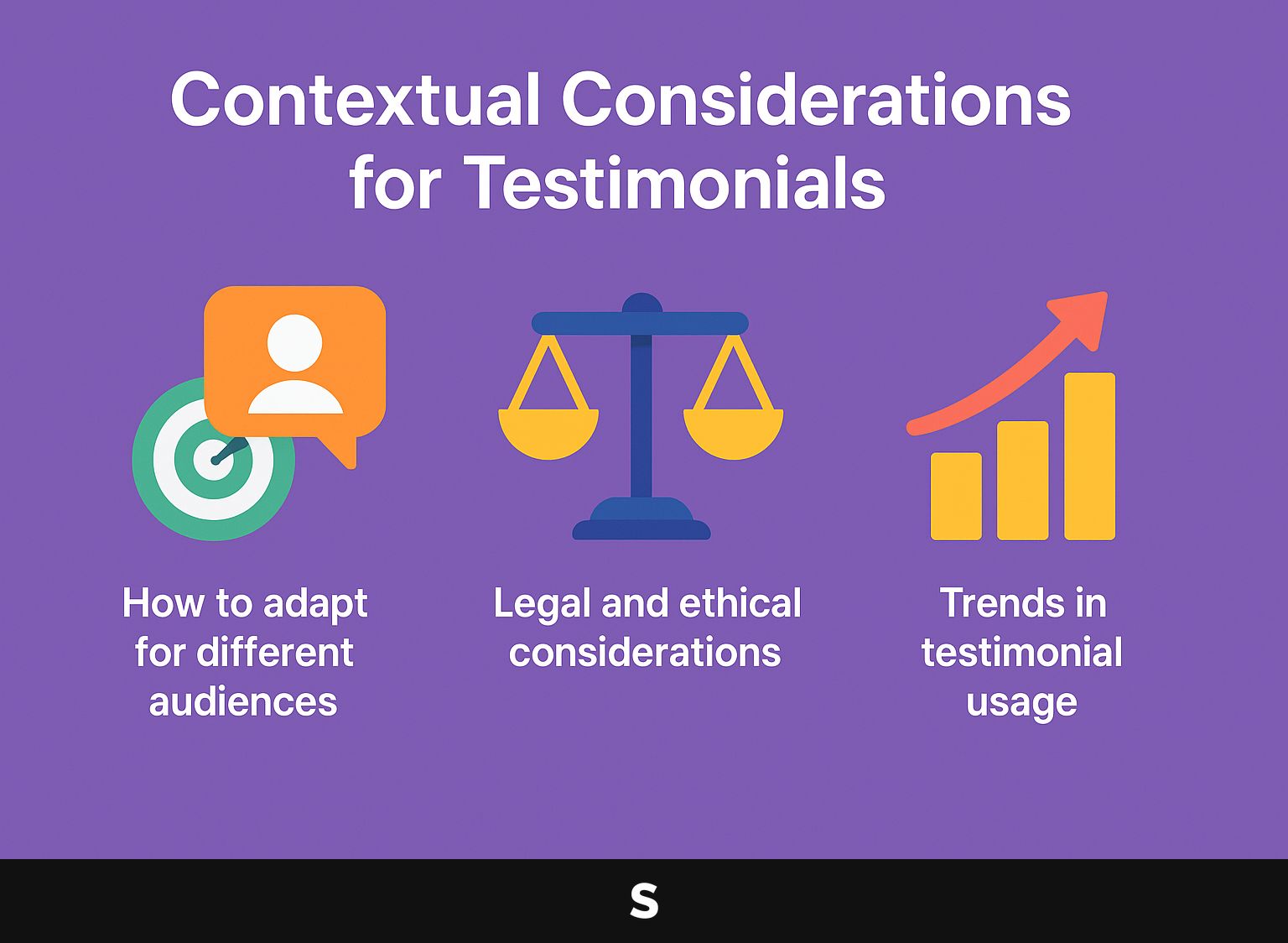
How to change testimonials for various groups of people
Changing testimonials for different groups means adjusting the words, main points, and feelings to match what each group cares about and expects.
Begin by analyzing your audience demographics. For instance, if targeting millennials, use casual language and relatable scenarios.
Include particular challenges: a busy professional might find a testimonial about saving time more relatable.
Use tools like Google Analytics to identify audience behavior and preferences, then adjust the testimonials accordingly.
Test various versions on different platforms to see which one connects best with the audience. This method makes sure your testimonials connect with the audience and increase engagement and conversion rates.
Legal and ethical considerations in using testimonials
Knowing the legal and ethical rules for using testimonials is important to avoid problems and keep customer trust.
- First, always obtain explicit consent from the individuals whose testimonials you wish to use. This respects their privacy and improves your trustworthiness.
- Next, avoid making untrue claims; make sure that testimonials are real experiences without overstatement. For example, if a customer reports a 10% increase in sales, present that honestly instead of suggesting a ‘guaranteed’ outcome.
- Keep customer reviews up-to-date so they match what people think now. By following these practices, you build an open relationship with your audience.
Trends in testimonial usage across industries
Current trends in testimonial usage reveal a growing emphasis on video testimonials and user-generated content, which are increasingly favored by consumers across industries.
For example, brands like Nike use video testimonials on social media to create real emotional connections with their audience.
In the beauty industry, Glossier builds a community by displaying content created by users on its website, which increases trust and involvement.
Tools like Vimeo or Instagram Reels can help businesses easily produce these testimonials, while platforms like Yotpo aid in aggregating user reviews.
When companies show testimonials in different ways and with real voices, they can greatly increase their trustworthiness and encourage more sales, effectively helping their use of testimonials.
Frequently Asked Questions
Why change brief feedback into strong marketing reviews?
Turning brief feedback into strong marketing testimonials lets businesses show customers’ good experiences. It highlights what makes them special, the benefits customers get, and how it makes them feel. This creates powerful social proof that can be used on websites, ads, and proposals.
How does Spokk.io convert short comments into effective marketing testimonials?
Spokk.io employs AI tools to expand short comments into complete and impactful marketing testimonials. This process involves focusing on the key points of the feedback, like specific benefits and emotional reactions, to create an engaging testimonial.
Why are marketing testimonials important for businesses?
Marketing testimonials serve as powerful social proof for businesses, showcasing the positive experiences and satisfaction of their customers. This can help bring in new customers and strengthen trust in the brand, which can lead to more sales and higher revenue.
Can marketing testimonials be used in different forms of marketing?
Yes, marketing testimonials can be used in various forms of marketing, such as on websites, ads, and proposals. They can be shared on social media and added to email promotions to increase trust and bring in new customers.
How can businesses use AI-powered testimonials to distinguish themselves from their competitors?
By using AI-powered testimonials, businesses can highlight what makes them different, the particular advantages they offer, and the feelings their products or services create. This can help build a clear and appealing brand image that can draw in and keep customers.
Are there any specific guidelines for creating powerful marketing testimonials?
To create effective marketing testimonials, businesses should focus on highlighting the most important aspects of the customer’s experience, using specific and detailed language, and including emotional outcomes. It’s also important to get permission from the customer before using their feedback as a testimonial.
